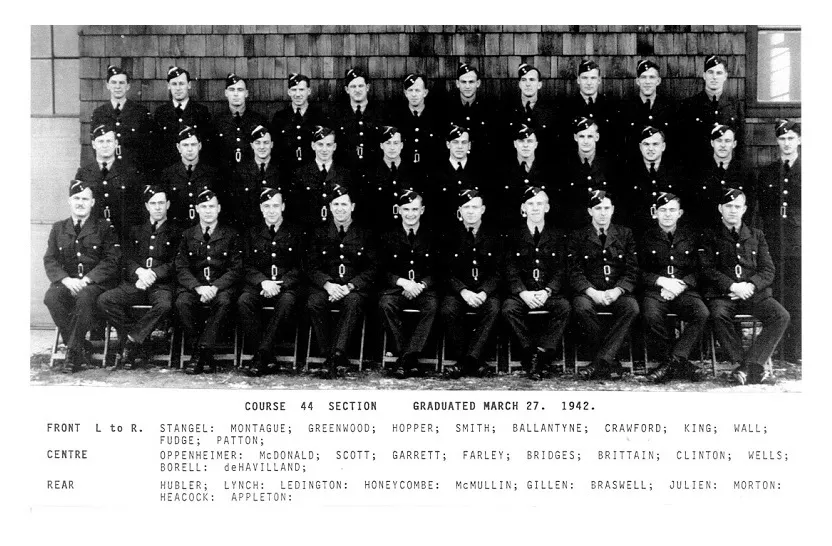Panting, Reginald (Leading Aircraftman)
Killed in Flying Accident 1944-January-17


Birth Date: 1925
Born:
Parents: Albert John Charles and Edith Mary Panting, of Toronto, Ontario.
Spouse:
Home: Toronto, Ontario, Canada
Enlistment:
Enlistment Date: unkown date
Service
RCAF
Unit
6 SFTS- Service Flying Training School
Base
Dunnville, Ontario, Canada
Rank
Leading Aircraftman
Position
Pilot
Service Numbers
R/206218
This incident involved multiple aircraft:
- Harvard Mk.IIB Serial: 3322
- Harvard Mk.II Serial: 3149
All the above aircraft in the above list are referenced in this report.
Accident Card - North American Harvard Mk.II serial:3149
This accident involved 2 aircraft on 1944-January-17. They are: Harvard II s/n 3322, Harvard II s/n 3149.
This accident involved 2 people. Panting R, Stewart HE
This accident had 2 fatalities. Leading Aircraftman Harold Charles Edward Stewart RCAF Killed in Flying Accident service no:R/210519 Harvard 3322,Leading Aircraftman Reginald Panting RCAF Killed in Flying Accident service no:R/206218 Harvard 3149
Harvard serial: 3149

Canadian Warplane Heritage Museum
The North American Harvard appeared in 1937, in response to a US Air Corps proposal for an advanced trainer. The first of 50 Harvard Mk. Is ordered by the Canadian Government were delivered to RCAF Sea Island, BC in July 1939. By early 1940, the Mk. II was being assembled in California with an all metal fuselage replacing the original tube and fabric structure. 1200 Mk. IIs were supplied from US sources, until Canadian built Harvards started being produced in 1941.
In August 1938, Noorduyn Aviation of Montreal farsightedly signed an agreement with North American, to build the Harvard under licence. When the British Commonwealth Air Training Plan (BCATP) came into being in December 1939, Noorduyn received its first orders and went on to produce nearly 2800 Harvard Mk. IIBs for the RCAF and the RAF, between 1940 and 1945. In Canada, Harvard Mk. IIBs were used as advanced trainers with the BCATP at fifteen Service Flying Training Schools across the nation. They helped pilots make to the transition from low powered primary trainers, like Fleet Finch or the de Havilland Tiger Moth, to high performance front line fighters such as the Spitfire.
At the end of WW II, although the RCAF retained the Harvard as a trainer, a large number of them were sold off to civilian operators. The RCAF soon regretted this, for by 1949 the Cold War with the Soviet Union was in full swing and the RCAF urgently needed trainers again. 100 T-6J Texans were leased temporarily from the USAF and a further 270 Harvards, the Mk. IV version, were ordered from Canadian Car & Foundry, Thunder Bay. The RCAF used the Harvard Mk. IV for a further fifteen years, before finally retiring it in 1966.
A total of 20,110 Harvards were built between 1938 and 1954, 3,370 of them in Canada. Countless numbers of privately owned Harvards are still flying today.
Canadian Warplane Heritage Museum's Harvard Mk. IV was built by Canadian Car & Foundry, Thunder Bay, Ontario in late 1951. The aircraft saw service at four RCAF flying schools across the nation until it was sold to a civilian owner in 1965. It was the third aircraft to join the Museum after Dennis Bradley, Alan Ness and John Weir donated it in 1973. Canadian Warplane Heritage Museum
Aircraft Images
Harvard 3322
Harvard Mk.IIB 3322
Used by No. 6 Service Flying Training School at Dunnville, Ontario. Mid air with Harvard 3149, 1/2 mile NW of Dundalk, Ontario. Leading Aircraftman H.C.E. Stewart killed.1942-03-23 Taken on Strength 2019-08-20
1943-June-10 Accident: 6 Service Flying Training School Loc: Aerodrome Names: Doering | Duck
1944-January-17 Accident: 6 Service Flying Training School Loc: Dundalk Names: Panting | Stewart
1944-02-03 Struck off Strength Struck off after crash, broken up for spares. 2019-08-20
Harvard 3149
Harvard Mk.II 3149
Served with No. 2 & 3 Training Command. With No. 6 Service Flying Training School at Dunnville, Ontario at time of crash. Mid air with Harvard 3322, 1/2 mile NW of Dundalk, Ontario. Leading Aircraftman R. Panting killed.1941-06-02 Taken on Strength 2019-08-20
1942-September-11 Accident: 13 Service Flying Training School Loc: Aerodrome Names: Taylor
1943-January-13 Accident: 6 Service Flying Training School Loc: Aerodrome Names: Finlayson | Wood
1943-April-27 Accident: 6 Service Flying Training School Loc: Aerodrome Names: Mcdonald
1944-January-17 Accident: 6 Service Flying Training School Loc: Dundalk Names: Panting | Stewart
1944-02-03 Struck off Strength Struck off, after Category A crash on 22 (or 17?) January 1944. 2019-08-20
Unit Desciption
6 SFTS (6 Service Flying Training School)
Graduates of the EFTS "learn-to-fly" program went on a Service Flying Training School (SFTS) for 16 weeks. For the first 8 weeks the trainee was part of an intermediate training squadron; for the next 6 weeks an advanced training squadron and for the final 2 weeks training was conducted at a Bombing & Gunnery School. The Service schools were military establishments run by the RCAF or the RAF.
There were two different types of Service Flying Training Schools. Trainees in the fighter pilot stream went to an SFTS like No. 14 Aylmer, where they trained in the North American Harvard or North American Yale. Trainees in the bomber, coastal or transport pilot stream went to an SFTS like No. 5 Brantford where they learned multi-engine technique in an Airspeed Oxford, Avro Anson or Cessna Crane.

For More Information on RCAF Station Dunnville see here
RCAF.info - RCAF Station Dunnville Ontario
RCAF.info - Relief Landing Field Welland Ontario